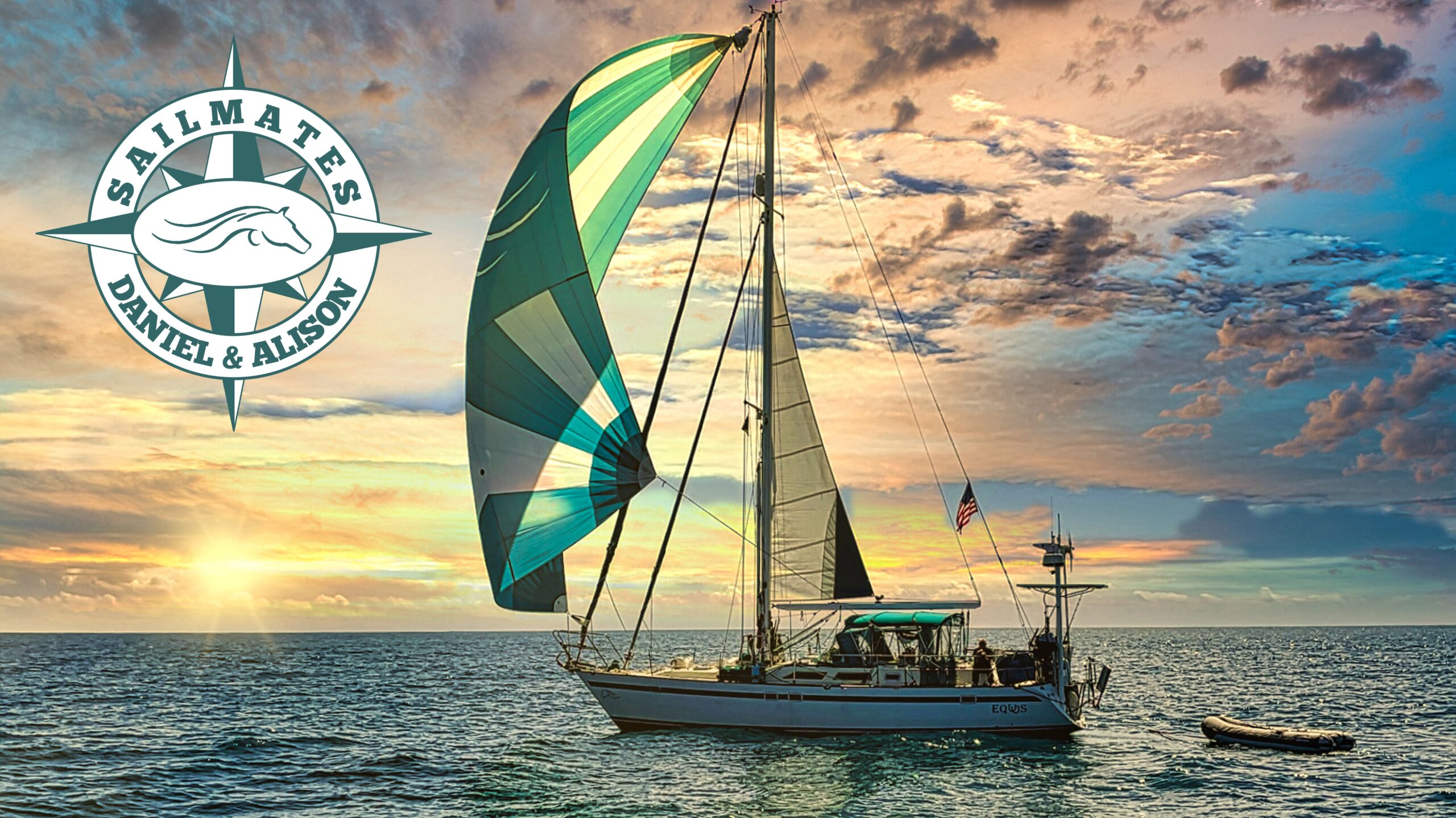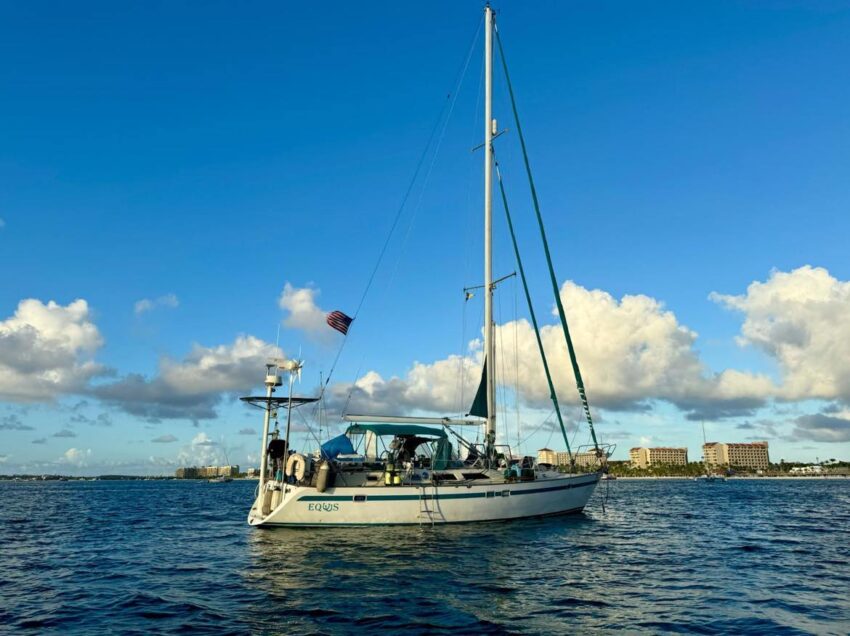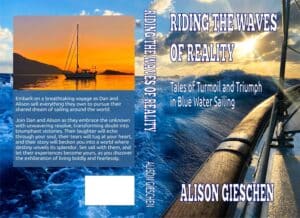Bonaire
After our long delay in Cape Verde waiting for our new autopilot, we finally got our weather window to make the 1,800-mile voyage across the Atlantic. We made landfall in Barbados and reacquainted ourselves with the warm, crystal-clear waters of the Caribbean, the steady breezes, and the spectacular sunsets. We had previously sailed the Caribbean islands but the southern Caribbean is not often visited by sailboats as their location makes getting there easy, but you must sail upwind, against the trade winds, to return to the heart of the Caribbean. However, if you are circumnavigating, you can sail to these islands and then continue to South America, a common route for those sailing around the globe.
There is something special about sailing through the ABC islands—Bonaire, Curacao, and Aruba. We’ve been lucky enough to visit all three. Each one has its own charm and personality. They may be close in distance, but each offers a unique experience, especially for those who love the ocean and its treasures. So, if you want to explore the Caribbean on your boat or are planning a visit, let’s talk about the ABCs—starting with Bonaire.
Sailing Bonaire
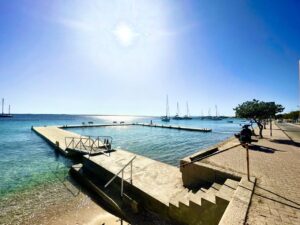
We did not meet any other cruisers in Bonaire. There was a grocery store within walking distance of the harbor and lots of quaint shops, restaurants, and bars. It’s not an island where you are likely to socialize unless you are traveling with other sailboats.
Bonaire: Diving Heaven
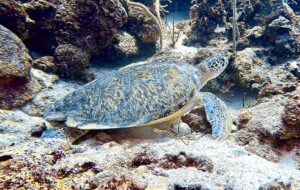
What is cool is that you don’t need a boat to reach many of these sites—just drive along the coast, park your car, and walk right in! We were able to reach many of the sites by dinghy. There is an island across from the main harbor which is quite a distance by dinghy. We ventured there but were wary of making the trip in the afternoon when the wind kicked up. The waves build up and it would be a struggle to get back to the boat. There are lots of dive shops that will bring divers to all the good locations.
Bonaire is all about easy, shore diving and even diving right off the back of your own boat. The island also has a laid-back vibe. It is not packed with high-rise hotels or mega-resorts, so it feels more like a place where you can truly relax.
Historically, Bonaire has a Dutch heritage. In the early 1600s, the Dutch took over the island, and their influence is still strong today. Most people speak Dutch, but Papiamento—a Creole language mixing Spanish, Portuguese, Dutch, and African dialects—is also widely spoken. The island’s population is mostly a mix of African, European, and Caribbean backgrounds, and they are some of the friendliest people you will meet.
What to See and Do
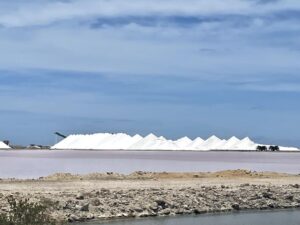
Our favorite part of the day was winding up into the hills to Bonaire’s distillery. The Cadushy is the only distillery on the island. Located in the historical village of Rincon, the distillery produces unique liqueurs and spirits inspired by the island’s traditions. One of its standout products is the “Cadushy of Bonaire Liqueur,” made from the island’s native cactus.
The distillery’s liqueurs are made in small batches using sustainable practices, and they have a strong focus on preserving the cultural heritage of Bonaire. The name “Cadushy” itself refers to the cactus used to create their signature product, reflecting the natural environment of the island. Over time, the distillery expanded to create spirits representing the entire Dutch Caribbean and only use the plants found on the Dutch islands to make their products.

We only stayed a week in Bonaire as it was expensive to be on a mooring ball, but we thoroughly enjoyed our time there. The next hop, Curacao, was a 40-mile trip west, an easy half-day sail. However, the entrance to the harbor involves navigating into a narrow inlet and continuing down a river. This is not advisable to attempt at night. We stopped for the night at a Kline Curacao, or Little Curacao, twenty miles from the main island, and anchored for the night. Early the next morning, we made our way to the mainland to safely navigate the channel and check into the country.
Curacao
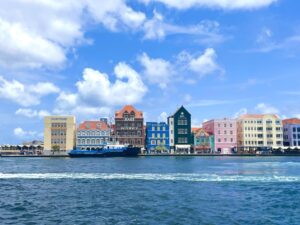
Curacao’s history is tied closely to trade. The island was a major hub for commerce and shipping, and you can still feel that influence today with its vibrant mix of cultures. The people here speak Dutch, English, and Papiamento, just like in Bonaire. The island has restaurants from every ethnic background.
The local food is a tasty blend of Caribbean, Dutch, and Latin American influences. Try the “Keshi Yena,” a stuffed cheese dish—it is delicious! They have lots of shopping and incredible supermarkets. The price of food is very reasonable.
Sailing Curacao
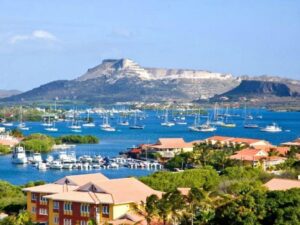
First, we had to get our dinghy to shore and tie up at the one small dock where sailors were allowed to leave their dinghies. Next, we had to find the closest bus stop and figure out the schedule. We had to take a forty-minute bus ride into the center of Willemstad where the offices were located. There were two issues. One, the customs office temporarily moved and two, we were a mile away from the other two offices. To make a long story short, we had a terrible time finding the customs office. Then, we had the long walk to the other two offices which were located on the opposite side of the river. We ended up walking over four miles in 90-degree heat. Then, we had to wait two hours for our bus back to the harbor as we just missed the bus we were shooting for. By the time we got back to our boat, I was not a fan of Curacao. I told Dan that I did not want to stay. Six weeks later, I was a huge fan.
Once you get through the check-in process, you can relax and enjoy Curacao. You can stay in the harbor for three months. The only fee is a $25 anchoring permit. For an additional $25, and another trip into the city, you can get a three-day anchoring permit for Little Curacao or another harbor on the main island. Later in our visit we sailed the four hours to Little Curacao with four other sailboats and had a mini holiday on our own private island.
As many sailboats come to this protected harbor in Curacao to wait out hurricane season, there is an active and thriving liveaboard community. In the past, there used to be “cruiser nets.” At 8:00 AM you had to turn on your ship radio and tune into the local channel. Whoever oversaw the net would give news, weather, new arrivals, and activities. WhatsApp has replaced the nets. Now, cruisers communicate all day long with messages about resources and activities. For instance, there is a shopping bus that takes cruisers on Mondays and Thursdays to the local grocery store for free.
There were weekly game tournaments at local restaurants like Mexican Train, Rummicub, and Poker. Monday nights was burger night at Mr. J’s which was mostly a social event. Tuesday was Captain’s night at the fresh-caught seafood restaurant where you picked out your fresh seafood and had it cooked and brought to your table.
If you needed to rent a car, do laundry, or buy or sell a boat part, information and answers were provided via WhatsApp. It is a game changer and a great way to meet other cruisers and share activities. I even found a boat giving away sourdough starter and was able to dinghy to the boat and get my sourdough obsession started again.
During our time in Spanish Water, we met sailors from our past and made new friends. It was amazing after three years of being isolated from sailing friends to be back in a community. We took hikes, group dives, car trips, and excursions with our boat buddies. We filled that empty space we often feel of being alone on this long voyage. The best part is that many of us are on the same path to sail to Panama and cross through the Panama Canal into the Pacific. We are sure we will all be meeting up again as sailors often head to the same popular ports.
Diving Curacao
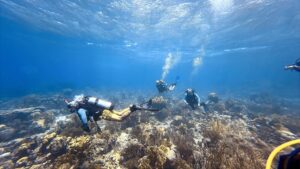
We did shore dives on a tug boat wreck, rented cars are went to remote locations with spectacular diving. The sea life, corals, and reefs were healthy and diverse. The best part was that we were able to share the experiences with our boat friends. Our favorite diving was when we ventured off to Little Curacao. We had to venture back into the city, got our three-day permits, and then set off on the four-hour sail. Since the island is uninhabited, we had the place to ourselves every afternoon after the tourist boats left. We explored the island, had beach barbeques, and could dive right off our boat. We also went to the windy side and did a drift dive where the untouched corals were the healthiest and most vibrant, we have ever seen.
What to See and Do
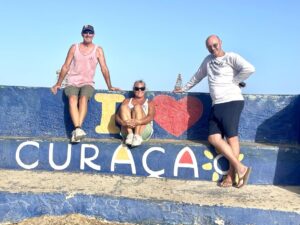
We took several trips into the city for boat parts and other needs. We learned the bus system and had no issues traveling around the island. In the city was an amazing fresh fruit and veggie market. We bought avocados the size of small melons, 3 for $5. The fruit and veggies we inexpensive and so fresh.
Our outings included hiking to a spot along the coast where you dive off a cliff, into the ocean. There you find a cave under the cliff. You must swim underwater and pop up inside the cave. It is called The Blue Room Cave. When you arrive inside, the light shines in and highlights the water and fish in an ethereal blue light. We also went diving off a beach so beautiful, that we felt like we were on an exotic tropical island. The beach is famous for the pigs who live there, wandering around between sunbathers looking for treats. We had pina coladas and excellent barbeque for lunch. The dive was unique. You weaved between giant pinnacles of coral that were as tall as 100 ft. The sights were surreal.
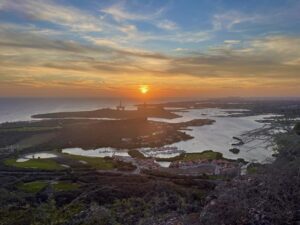
Finally, it was time to move on to Aruba. We were on a timeline as we were meeting friends from the US there. It was a 60-mile downwind sail to Aruba. We left at 5 Am and arrived by 3:00 at the customs dock to check into the island of Aruba.
Aruba: The “Happy Island”
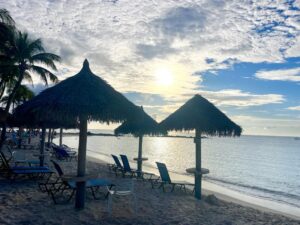
Aruba has a mix of people from all over the world. You will hear Dutch, English, and Spanish spoken everywhere, but Papiamento is the heart language. It was developed as a way for slaves and merchants to communicate and combine elements of Portuguese, Spanish, Dutch, and West African languages. It is a true symbol of the island’s diversity and resilience.
The fancy resorts and the plethora of shops and amazing restaurants make Aruba a Caribbean vacation destination. It is extremely easy for Americans to fly here and you can use American dollars. Sitting on one of the white sand beaches, under a palapa (small hut covered with palm fronds), with the unbelievably blue, warm ocean gently lapping on the shore, you will feel like you are in heaven.
Sailing Aruba
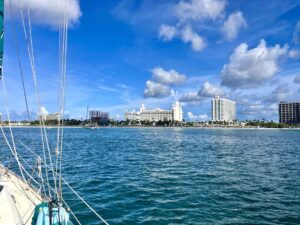
Checking into Aruba is easy if you follow the protocol. As soon as you arrive, you must go straight to Barcardera Harbor which has a pier with customs and immigration. They are quite strict about this rule. The dock will mostly be lined with fishing vessels. There is a small gap to get to the dock, shallow water on one side, and fishing boats on the other. It is a bit tricky getting in but certainly doable. Once checked in, you can stay in Aruba for 30 days.
You have a choice of a few harbors on the western side of the island. As this is an island safe from hurricanes, it is a stopping point for those circumnavigating on the way to South America. We chose to anchor in Palm Bay. We are facing the huge fancy hotels and resorts. We met friends of ours here who stayed in one of the resorts. It was awesome to dinghy to shore and enjoy the amenities of the resort, then dinghy back to our boat each evening. The beach has a pier with a restaurant and live music each night. We have a perfect view of the sunset, then we can hear the live music drifting across the water with the backdrop of the sparkling lights of the hotels.
We will head to some of the other harbors while we are here before heading off to Columbia.
Diving Aruba
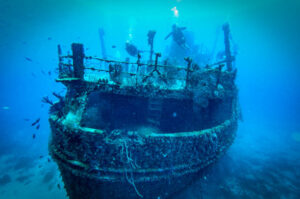
The diving in Aruba is all about wrecks. There’s the “Antilla,” one of the largest shipwrecks in the Caribbean, and a few others like the “Jane Sea” and “Pedernales.” The waters can have less visibility than the other islands as there is a constant breeze stirring the sea, but it does have good visibility days. The myriad of wrecks are unique and fascinating and full of history and mystery. You can find stingrays, moray eels, octopuses, and lots of macro life here.
Some of the dive sites are too far to take a dinghy. Aruba Water Sports has an amazing staff of dive masters who will take you to various sites and guide you through the wrecks and reefs. The staff is very experienced and are a fun group of people. We took a few dives with them and loved their helpfulness and animated personalities.
Night diving is spectacular here. There is nothing like weaving through the wrecks in the inky darkness and experiencing the unique creatures that come alive at night.
What to See and Do
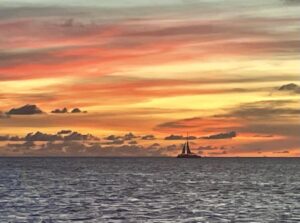
Up on the northern tip of the island is the California Lighthouse. It’s named after the S.S. California, a ship that wrecked nearby in the early 1900s. The lighthouse offers panoramic views of the coastline and surrounding desert landscape. Nearby, the capital city of Oranjestad is a charming mix of Dutch colonial architecture and Caribbean flair, with colorful buildings lining the streets, and plenty of shops, restaurants, and museums to explore. On the eastern side of the island, the Natural Bridge and Baby Bridge are worth a visit. Although the original Natural Bridge collapsed in 2005, the site remains popular for its wild, natural beauty, with waves crashing against the rocky coastline.
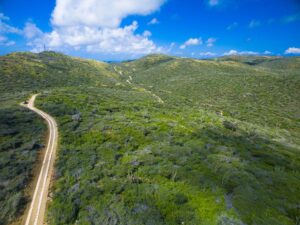
One of the more adventurous spots is the Natural Pool, or “Conchi,” which is a secluded natural rock formation that creates a pool where you can swim and snorkel. It’s located within Arikok National Park, and getting there is an adventure in itself since you need a 4×4 vehicle or a guided tour. But once you’re there, it’s worth it for the clear water and the chance to explore the rugged coastline. These are just a few of Aruba’s highlights, but there’s so much more to see and do depending on what interests you. Whether you’re into history, nature, or just soaking up the sun, Aruba has something for everyone.
Where We Go from Here
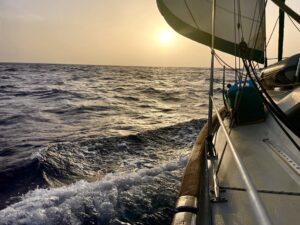
The best we can do is make a general game plan. We never know what will happen between now and the time we arrive. Our plans are always a rough sketch. If there is one thing we have learned sailing around the globe over the last seven years, is that our actual path is usually not the one we planned for or anticipated. What we do know is that we are exactly where we need to be when we need to be there. We are okay with that. As long as we are alive, in love, and still afloat, it’s all good. Each place we visit is a wonderful new experience and an education about the world around us. That is what this journey is all about.
Fair Winds,
Alison and Dan
S/V Equus
CHECK OUT THE LAUNCH OF OUR BOOK: RIDING THE WAVES OF REALITY: TALES OF TURMOIL AND TRIUMPH IN BLUE WATER SAILING
AVAILABLE NOW ON AMAZON IN PRINT AND ON KINDLE
JOIN US FOR THE ADVENTURES OF OUR FIRST FIVE YEARS OF CIRCUMNAVIGATION

